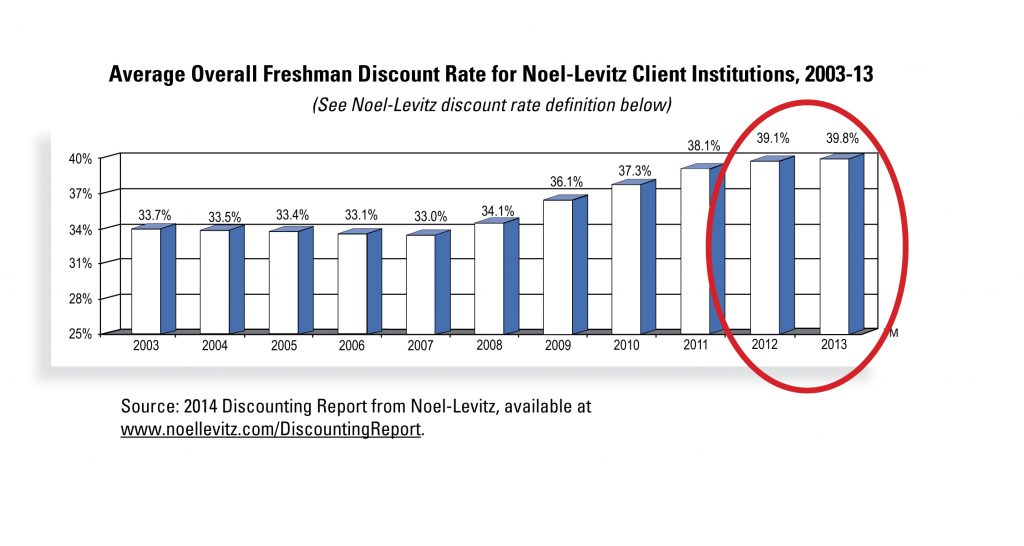enrollment
Fall 2013 discounting benchmarks from Noel-Levitz client institutions
This is an active time of year for college and university financial aid offices, with financial aid award packages being assessed from a variety of vantage points. Hence, it seems fitting to look back to what happened last year after the dust settled, particularly to discounting at private institutions that partnered with Noel-Levitz to manage their unfunded institutional gift aid.
According to the latest annual Noel-Levitz discounting report, the average overall freshman discount rate increased 0.7 percentage points from fall 2012 to fall 2013 at the 163 nonprofit private campuses using Noel-Levitz statistical resources and consulting to manage their institutional gift aid. This increase is shown in the red-circled area below and is based on the Noel-Levitz definition of discounting (as described at the bottom of this blog post).
 The chart’s 10-year trendline for Noel-Levitz client institutions (a set of institutions that changes slightly from year to year) shows the overall freshman discount rate was relatively steady between 2003-08, then rose 2 percentage points in 2009 when the recession hit. Since then, the rate of increase has averaged less than one percent per year, rising 1.2 points in 2010, 0.8 points in 2011, 1.0 point in 2012, and 0.7 points in 2013.
The chart’s 10-year trendline for Noel-Levitz client institutions (a set of institutions that changes slightly from year to year) shows the overall freshman discount rate was relatively steady between 2003-08, then rose 2 percentage points in 2009 when the recession hit. Since then, the rate of increase has averaged less than one percent per year, rising 1.2 points in 2010, 0.8 points in 2011, 1.0 point in 2012, and 0.7 points in 2013.
More highlights from the report:
- The 0.7 percent increase in discounting in 2013 resulted in 1.7 percent average growth in per-student net revenue for these institutions that used Noel-Levitz services in 2013 versus the average per-student net revenue of a similar set of institutions that used Noel-Levitz services in 2012.
- Once again, in 2013, discounting was highest among small colleges and universities in the study.
- An average of 76.9 percent of the institutionally funded merit aid/scholarship awards made by the Noel-Levitz client institutions in 2013 went directly to meet demonstrated financial need.
It’s important to remember that increases in discounting reflect an institution’s commitment to students’ and families’ ability to enroll as college costs continue to rise. Rather than risk lowering their enrollment and retention, these colleges have provided greater amounts of assistance in order to maintain affordability.
How Noel-Levitz defined the overall discount rate
When calculating discount rates, studies and campus officials often include tuition and fees but exclude room and board. However, since many private institutions are residential, Noel-Levitz included room and board fees to more accurately identify revenue flows tied to enrolling students. In addition, Noel-Levitz’s definition of discounting focuses on unfunded/unrestricted gift aid—sources of aid over which institutions have discretion and control. We believe this definition offers a more accurate view of discounting than including restricted funds (primarily endowed), given that such sources of aid are paid from monies that are unavailable for other uses. For more information, see page 2 of the report.
Questions? Would you like to confidentially discuss your discounting strategy?
I hope you found this blog post helpful. If you are working to fine-tune your discounting strategies and would like an outside perspective on how to reduce or control discounting, email me to set up a time for a confidential telephone conversation.